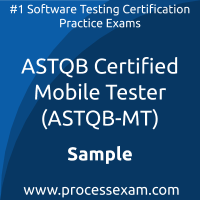 You have to pass the ASTQB-MT exam to receive the certification from ASTQB. To increase the effectiveness of your study and make you familiar with the actual exam pattern, we have prepared this sample questions. Our Sample ASTQB Certified Mobile Tester Practice Exam will give you more insight about both the type and the difficulty level of the questions on the ASTQB-MT exam.
You have to pass the ASTQB-MT exam to receive the certification from ASTQB. To increase the effectiveness of your study and make you familiar with the actual exam pattern, we have prepared this sample questions. Our Sample ASTQB Certified Mobile Tester Practice Exam will give you more insight about both the type and the difficulty level of the questions on the ASTQB-MT exam.
However, we are strongly recommending practice with our Premium ASTQB Certified Mobile Tester (ASTQB-MT) Practice Exam to achieve the best score in your actual ASTQB-MT Exam. The premium practice exam questions are more comprehensive, exam oriented, scenario-based and exact match of ASTQB Certified Mobile Tester exam questions.
ASTQB Mobile Tester Sample Questions:
01. Which of the following requirements documents would be the best source to determine normal usage scenarios?
a) Requirements specification
b) Use cases
c) User stories
d) Usability requirements
02. In what way might a mobile device itself supply data to the mobile application?
a) By providing location information by using its geolocation capability
b) By gathering input from the user
c) By communicating with a backend system
d) By connecting to another device
03. You have a need to test network connectivity in a variety of environments to determine if your web site will respond fast enough and reliably enough to the requests from your mobile web-based application. You don’t have the ability to create these environments within your test facilities.
What is the best option to use to conduct this testing?
a) Find or develop a simulator that can simulate the network interaction of many devices on varied networks
b) Find or develop an emulator that can emulate the network interaction of many devices on varied networks
c) Find a cloud-based network simulator that can generate network traffic from a variety of different networks
d) Implement crowd-source testing to get a large number of people to use their own devices to connect via various networks
04. What is the best way to verify that a simulator is giving reliable results?
a) Read the requirements
b) Test the simulator
c) Compare the results to the results from a real device
d) Compare the results from the simulator to the results from an emulator
05. As lifecycle models adapt to meet the needs of the mobile application market, how will the interaction between the developers and testers change?
a) The interaction will become more formal
b) Detailed requirements documentation will replace stand up meetings
c) Developers and testers will return to more traditional, separate roles
d) Collaboration between developers and testers will increase
06. You are planning to conduct performance testing on a new application. You have been given a set of personas to use during this testing.
How should you apply the personas in the performance testing approach?
a) Personas should be duplicated by the automated tools to create virtual users who can create a realistic load on the system.
b) Personas should be reviewed to understand the individual tasks being performed. These tasks can then be scripted and performed in sets.
c) Personas are used primarily for usability testing and should not be used as guidelines for performance testing.
d) Personas should be used to derive use cases which can be broken down into user stories and then scripted into performance test scripts
07. In a project that is feature-rich but time-poor, which is the most reasonable approach to risk analysis?
a) Conduct a full risk analysis, including weighted likelihood and impact ratings for each item
b) Use a lightweight approach and assign relative importance of each identified item
c) Skip the risk analysis step and proceed to test execution based on experience
d) Concentrate on the functional capabilities and disregard the physical capabilities of the device since those should be tested by the manufacturer
08. When conducting security testing on a mobile application, which is the correct set of basic areas to cover?
a) Access, data protection, documentation
b) Code, functionality, documentation, security policy
c) Access, data storage, data transfer, security policy
d) Data creation, data storage, data transfer
09. What types of testing are particularly important for mobile applications based on the user’s expectations?
a) Suitability and Accuracy
b) Usability and Performance
c) Portability and Usability
d) Performance and Security
10. For a navigation application on a smart phone, which is the most importance device capability?
a) Telephony
b) Camera
c) Email
d) Geolocation
Answers:
Question: 01
Answer: b |
Question: 02
Answer: a |
Question: 03
Answer: c |
Question: 04
Answer: c |
Question: 05
Answer: d |
Question: 06
Answer: a |
Question: 07
Answer: b |
Question: 08
Answer: c |
Question: 09
Answer: b |
Question: 10
Answer: d |
If you find any errors or typos in ASTQB Certified Mobile Tester (ASTQB-MT) sample question-answers, please report them to us on feedback@processexam.com
 You have to pass the ASTQB-MT exam to receive the certification from ASTQB. To increase the effectiveness of your study and make you familiar with the actual exam pattern, we have prepared this sample questions. Our Sample ASTQB Certified Mobile Tester Practice Exam will give you more insight about both the type and the difficulty level of the questions on the ASTQB-MT exam.
You have to pass the ASTQB-MT exam to receive the certification from ASTQB. To increase the effectiveness of your study and make you familiar with the actual exam pattern, we have prepared this sample questions. Our Sample ASTQB Certified Mobile Tester Practice Exam will give you more insight about both the type and the difficulty level of the questions on the ASTQB-MT exam.